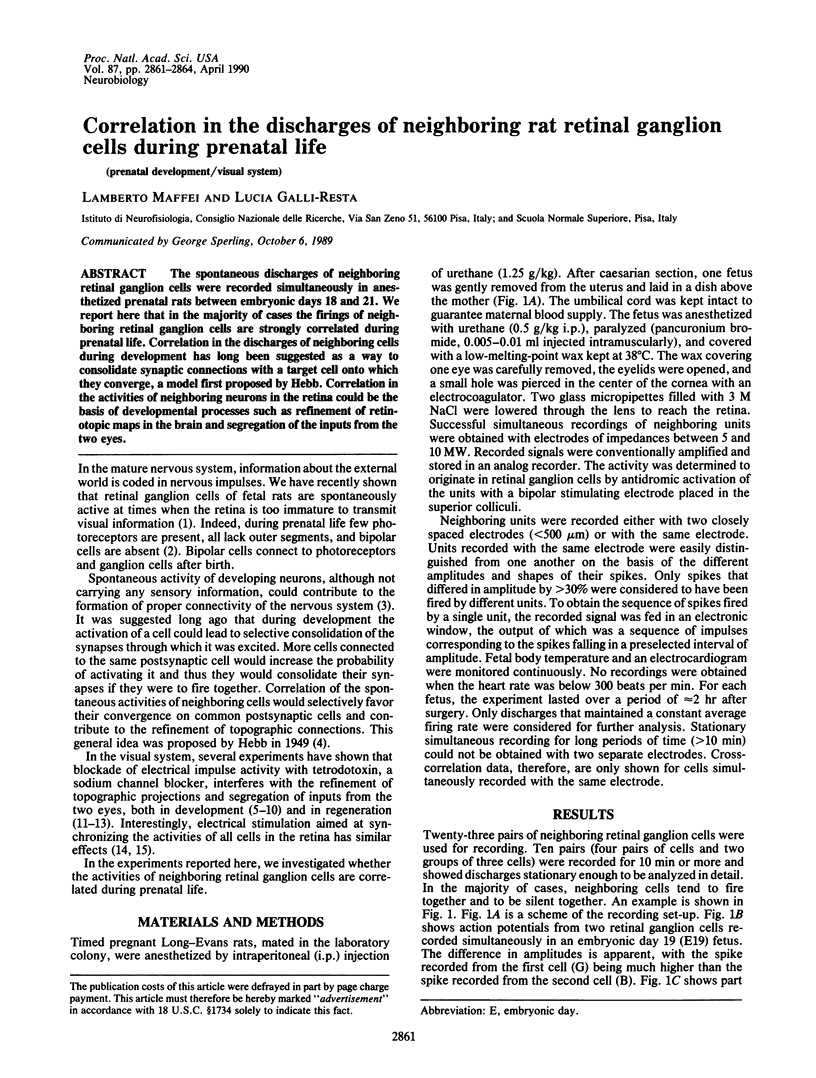Abstract
The spontaneous discharges of neighboring retinal ganglion cells were recorded simultaneously in anesthetized prenatal rats between embryonic days 18 and 21. We report here that in the majority of cases the firings of neighboring retinal ganglion cells are strongly correlated during prenatal life. Correlation in the discharges of neighboring cells during development has long been suggested as a way to consolidate synaptic connections with a target cell onto which they converge, a model first proposed by Hebb. Correlation in the activities of neighboring neurons in the retina could be the basis of developmental processes such as refinement of retinotopic maps in the brain and segregation of the inputs from the two eyes.
Full text
PDF



Images in this article
Selected References
These references are in PubMed. This may not be the complete list of references from this article.
- Dubin M. W., Stark L. A., Archer S. M. A role for action-potential activity in the development of neuronal connections in the kitten retinogeniculate pathway. J Neurosci. 1986 Apr;6(4):1021–1036. doi: 10.1523/JNEUROSCI.06-04-01021.1986. [DOI] [PMC free article] [PubMed] [Google Scholar]
- Galli L., Maffei L. Spontaneous impulse activity of rat retinal ganglion cells in prenatal life. Science. 1988 Oct 7;242(4875):90–91. doi: 10.1126/science.3175637. [DOI] [PubMed] [Google Scholar]
- Horsburgh G. M., Sefton A. J. Cellular degeneration and synaptogenesis in the developing retina of the rat. J Comp Neurol. 1987 Sep 22;263(4):553–566. doi: 10.1002/cne.902630407. [DOI] [PubMed] [Google Scholar]
- Mastronarde D. N. Correlated firing of retinal ganglion cells. Trends Neurosci. 1989 Feb;12(2):75–80. doi: 10.1016/0166-2236(89)90140-9. [DOI] [PubMed] [Google Scholar]
- Meyer R. L. Tetrodotoxin blocks the formation of ocular dominance columns in goldfish. Science. 1982 Nov 5;218(4572):589–591. doi: 10.1126/science.7123262. [DOI] [PubMed] [Google Scholar]
- Meyer R. L. Tetrodotoxin inhibits the formation of refined retinotopography in goldfish. Brain Res. 1983 Feb;282(3):293–298. doi: 10.1016/0165-3806(83)90068-8. [DOI] [PubMed] [Google Scholar]
- O'Leary D. D., Fawcett J. W., Cowan W. M. Topographic targeting errors in the retinocollicular projection and their elimination by selective ganglion cell death. J Neurosci. 1986 Dec;6(12):3692–3705. doi: 10.1523/JNEUROSCI.06-12-03692.1986. [DOI] [PMC free article] [PubMed] [Google Scholar]
- Reh T. A., Constantine-Paton M. Eye-specific segregation requires neural activity in three-eyed Rana pipiens. J Neurosci. 1985 May;5(5):1132–1143. doi: 10.1523/JNEUROSCI.05-05-01132.1985. [DOI] [PMC free article] [PubMed] [Google Scholar]
- Schmidt J. T., Edwards D. L. Activity sharpens the map during the regeneration of the retinotectal projection in goldfish. Brain Res. 1983 Jun 13;269(1):29–39. doi: 10.1016/0006-8993(83)90959-9. [DOI] [PubMed] [Google Scholar]
- Schmidt J. T., Eisele L. E. Stroboscopic illumination and dark rearing block the sharpening of the regenerated retinotectal map in goldfish. Neuroscience. 1985 Feb;14(2):535–546. doi: 10.1016/0306-4522(85)90308-2. [DOI] [PubMed] [Google Scholar]
- Shatz C. J., Stryker M. P. Prenatal tetrodotoxin infusion blocks segregation of retinogeniculate afferents. Science. 1988 Oct 7;242(4875):87–89. doi: 10.1126/science.3175636. [DOI] [PubMed] [Google Scholar]
- Sretavan D. W., Shatz C. J., Stryker M. P. Modification of retinal ganglion cell axon morphology by prenatal infusion of tetrodotoxin. Nature. 1988 Dec 1;336(6198):468–471. doi: 10.1038/336468a0. [DOI] [PubMed] [Google Scholar]
- Stryker M. P., Harris W. A. Binocular impulse blockade prevents the formation of ocular dominance columns in cat visual cortex. J Neurosci. 1986 Aug;6(8):2117–2133. doi: 10.1523/JNEUROSCI.06-08-02117.1986. [DOI] [PMC free article] [PubMed] [Google Scholar]



